Tata Motors Sustainable Practices
VerifiedAdded on 2021/06/14
|14
|3696
|274
AI Summary
TATA MOTOR’S BUSINESS SUSTAINABILITY PRACTICES10 BUSINESS SUSTAINABILITY PRACTICES Name: Institution: Course: Tutor: Date: 1.0.0 Introduction 32.0 2.0.0 Tata Motors 3 3.0.0 Tata Motors Sustainable Practices 4 3.1.0 Change of Code of Conduct and Policies 4 3.1.1 Packaging Material Reduction 4 3.1.2 Reduction on the Consumption of the Virgin Material 4 3.2.0 Resource Recovery Strategy 5 3.2.1 Life Aggregates 5 3.3.0 Waste Disposal Practices
Contribute Materials
Your contribution can guide someone’s learning journey. Share your
documents today.
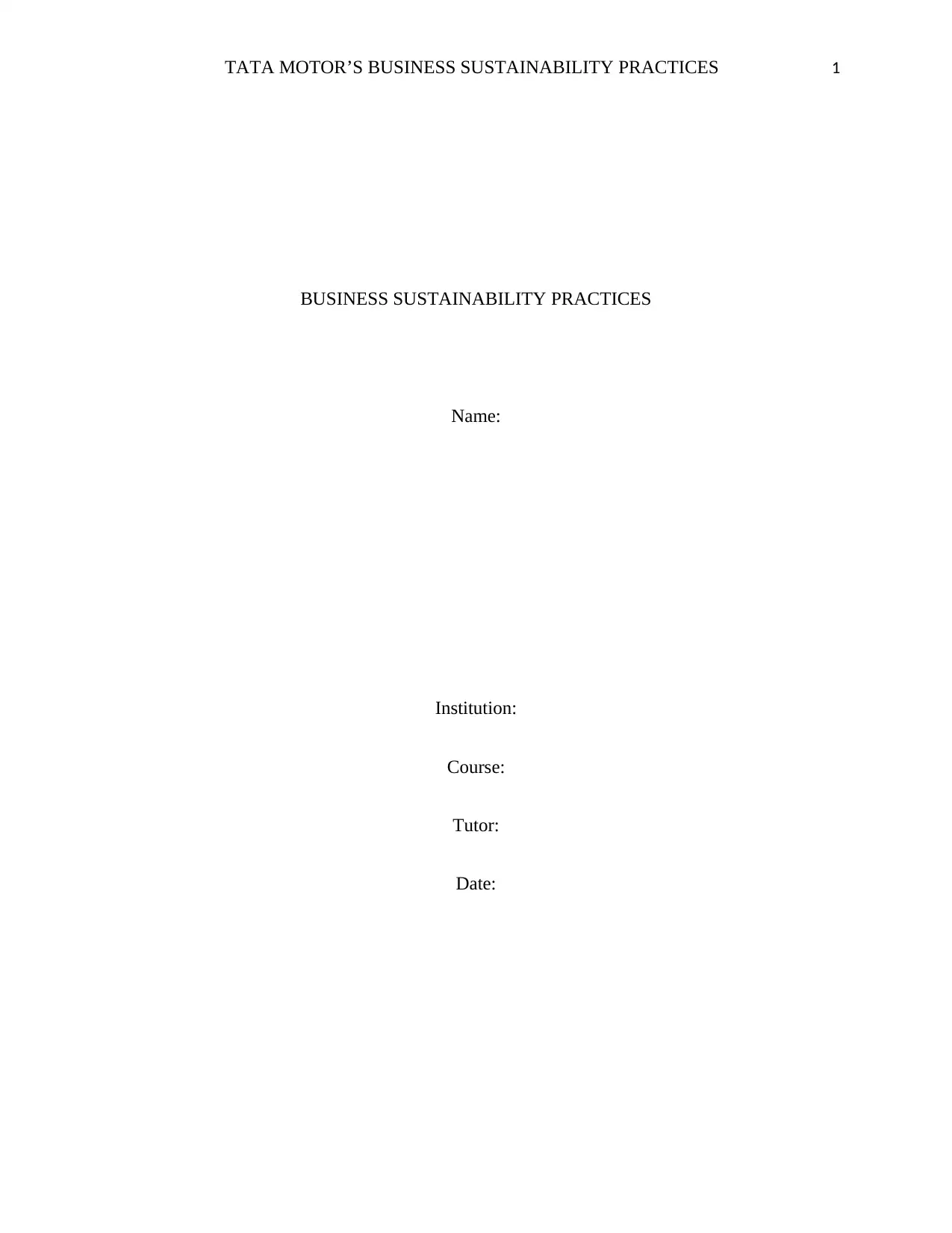
TATA MOTOR’S BUSINESS SUSTAINABILITY PRACTICES 1
BUSINESS SUSTAINABILITY PRACTICES
Name:
Institution:
Course:
Tutor:
Date:
BUSINESS SUSTAINABILITY PRACTICES
Name:
Institution:
Course:
Tutor:
Date:
Secure Best Marks with AI Grader
Need help grading? Try our AI Grader for instant feedback on your assignments.
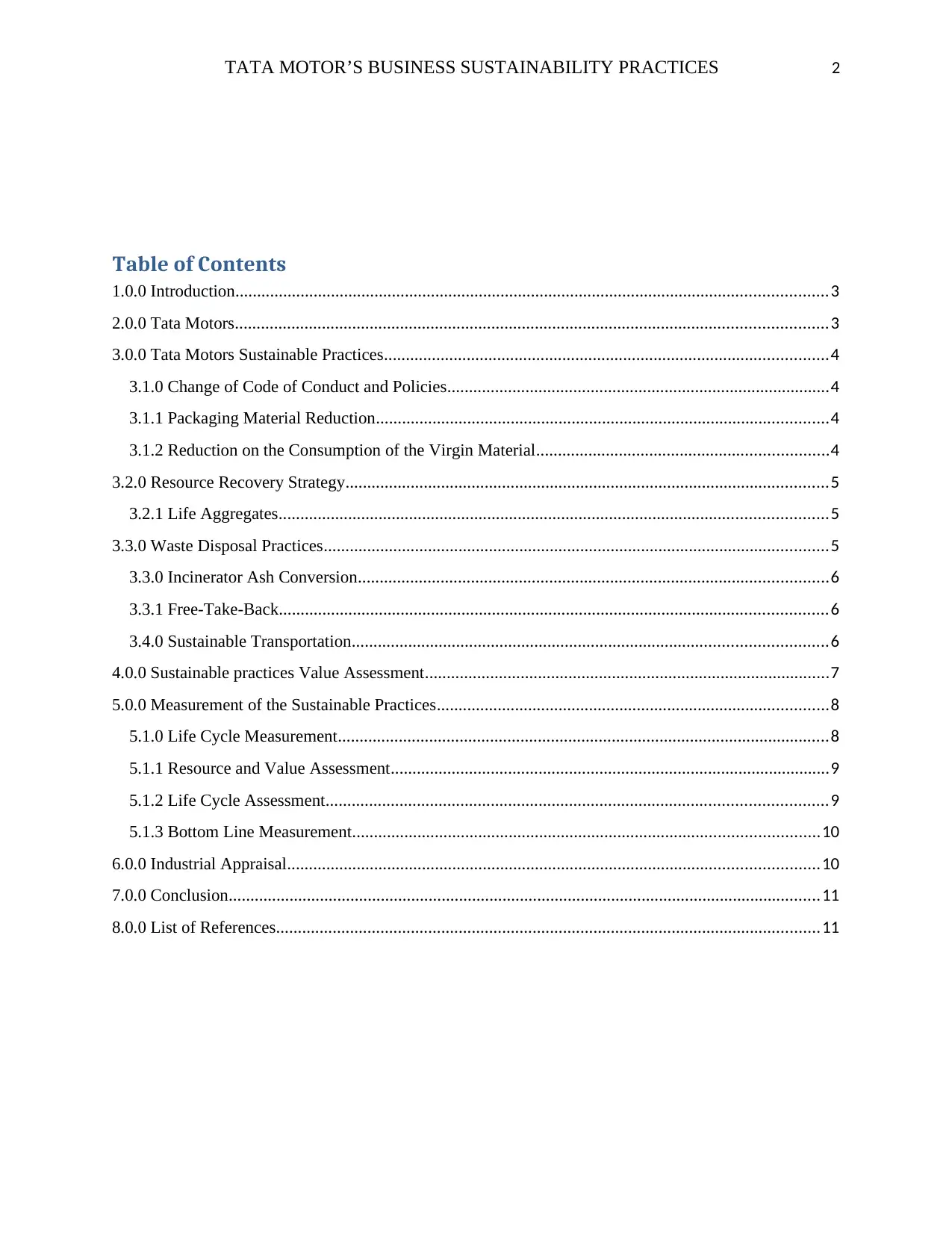
TATA MOTOR’S BUSINESS SUSTAINABILITY PRACTICES 2
Table of Contents
1.0.0 Introduction........................................................................................................................................3
2.0.0 Tata Motors........................................................................................................................................3
3.0.0 Tata Motors Sustainable Practices......................................................................................................4
3.1.0 Change of Code of Conduct and Policies........................................................................................4
3.1.1 Packaging Material Reduction........................................................................................................4
3.1.2 Reduction on the Consumption of the Virgin Material...................................................................4
3.2.0 Resource Recovery Strategy...............................................................................................................5
3.2.1 Life Aggregates..............................................................................................................................5
3.3.0 Waste Disposal Practices....................................................................................................................5
3.3.0 Incinerator Ash Conversion............................................................................................................6
3.3.1 Free-Take-Back..............................................................................................................................6
3.4.0 Sustainable Transportation.............................................................................................................6
4.0.0 Sustainable practices Value Assessment.............................................................................................7
5.0.0 Measurement of the Sustainable Practices..........................................................................................8
5.1.0 Life Cycle Measurement.................................................................................................................8
5.1.1 Resource and Value Assessment.....................................................................................................9
5.1.2 Life Cycle Assessment...................................................................................................................9
5.1.3 Bottom Line Measurement...........................................................................................................10
6.0.0 Industrial Appraisal..........................................................................................................................10
7.0.0 Conclusion........................................................................................................................................11
8.0.0 List of References.............................................................................................................................11
Table of Contents
1.0.0 Introduction........................................................................................................................................3
2.0.0 Tata Motors........................................................................................................................................3
3.0.0 Tata Motors Sustainable Practices......................................................................................................4
3.1.0 Change of Code of Conduct and Policies........................................................................................4
3.1.1 Packaging Material Reduction........................................................................................................4
3.1.2 Reduction on the Consumption of the Virgin Material...................................................................4
3.2.0 Resource Recovery Strategy...............................................................................................................5
3.2.1 Life Aggregates..............................................................................................................................5
3.3.0 Waste Disposal Practices....................................................................................................................5
3.3.0 Incinerator Ash Conversion............................................................................................................6
3.3.1 Free-Take-Back..............................................................................................................................6
3.4.0 Sustainable Transportation.............................................................................................................6
4.0.0 Sustainable practices Value Assessment.............................................................................................7
5.0.0 Measurement of the Sustainable Practices..........................................................................................8
5.1.0 Life Cycle Measurement.................................................................................................................8
5.1.1 Resource and Value Assessment.....................................................................................................9
5.1.2 Life Cycle Assessment...................................................................................................................9
5.1.3 Bottom Line Measurement...........................................................................................................10
6.0.0 Industrial Appraisal..........................................................................................................................10
7.0.0 Conclusion........................................................................................................................................11
8.0.0 List of References.............................................................................................................................11
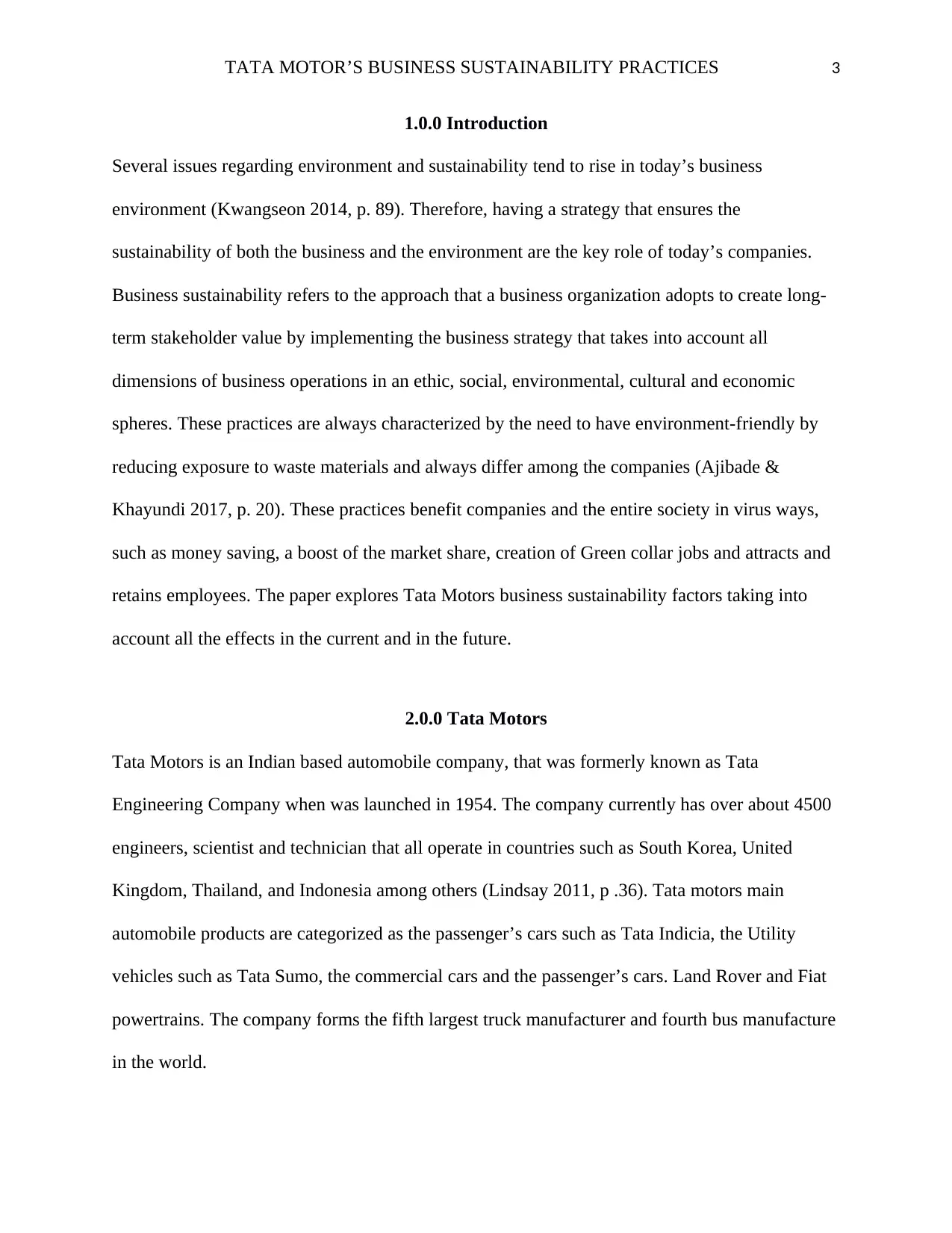
TATA MOTOR’S BUSINESS SUSTAINABILITY PRACTICES 3
1.0.0 Introduction
Several issues regarding environment and sustainability tend to rise in today’s business
environment (Kwangseon 2014, p. 89). Therefore, having a strategy that ensures the
sustainability of both the business and the environment are the key role of today’s companies.
Business sustainability refers to the approach that a business organization adopts to create long-
term stakeholder value by implementing the business strategy that takes into account all
dimensions of business operations in an ethic, social, environmental, cultural and economic
spheres. These practices are always characterized by the need to have environment-friendly by
reducing exposure to waste materials and always differ among the companies (Ajibade &
Khayundi 2017, p. 20). These practices benefit companies and the entire society in virus ways,
such as money saving, a boost of the market share, creation of Green collar jobs and attracts and
retains employees. The paper explores Tata Motors business sustainability factors taking into
account all the effects in the current and in the future.
2.0.0 Tata Motors
Tata Motors is an Indian based automobile company, that was formerly known as Tata
Engineering Company when was launched in 1954. The company currently has over about 4500
engineers, scientist and technician that all operate in countries such as South Korea, United
Kingdom, Thailand, and Indonesia among others (Lindsay 2011, p .36). Tata motors main
automobile products are categorized as the passenger’s cars such as Tata Indicia, the Utility
vehicles such as Tata Sumo, the commercial cars and the passenger’s cars. Land Rover and Fiat
powertrains. The company forms the fifth largest truck manufacturer and fourth bus manufacture
in the world.
1.0.0 Introduction
Several issues regarding environment and sustainability tend to rise in today’s business
environment (Kwangseon 2014, p. 89). Therefore, having a strategy that ensures the
sustainability of both the business and the environment are the key role of today’s companies.
Business sustainability refers to the approach that a business organization adopts to create long-
term stakeholder value by implementing the business strategy that takes into account all
dimensions of business operations in an ethic, social, environmental, cultural and economic
spheres. These practices are always characterized by the need to have environment-friendly by
reducing exposure to waste materials and always differ among the companies (Ajibade &
Khayundi 2017, p. 20). These practices benefit companies and the entire society in virus ways,
such as money saving, a boost of the market share, creation of Green collar jobs and attracts and
retains employees. The paper explores Tata Motors business sustainability factors taking into
account all the effects in the current and in the future.
2.0.0 Tata Motors
Tata Motors is an Indian based automobile company, that was formerly known as Tata
Engineering Company when was launched in 1954. The company currently has over about 4500
engineers, scientist and technician that all operate in countries such as South Korea, United
Kingdom, Thailand, and Indonesia among others (Lindsay 2011, p .36). Tata motors main
automobile products are categorized as the passenger’s cars such as Tata Indicia, the Utility
vehicles such as Tata Sumo, the commercial cars and the passenger’s cars. Land Rover and Fiat
powertrains. The company forms the fifth largest truck manufacturer and fourth bus manufacture
in the world.
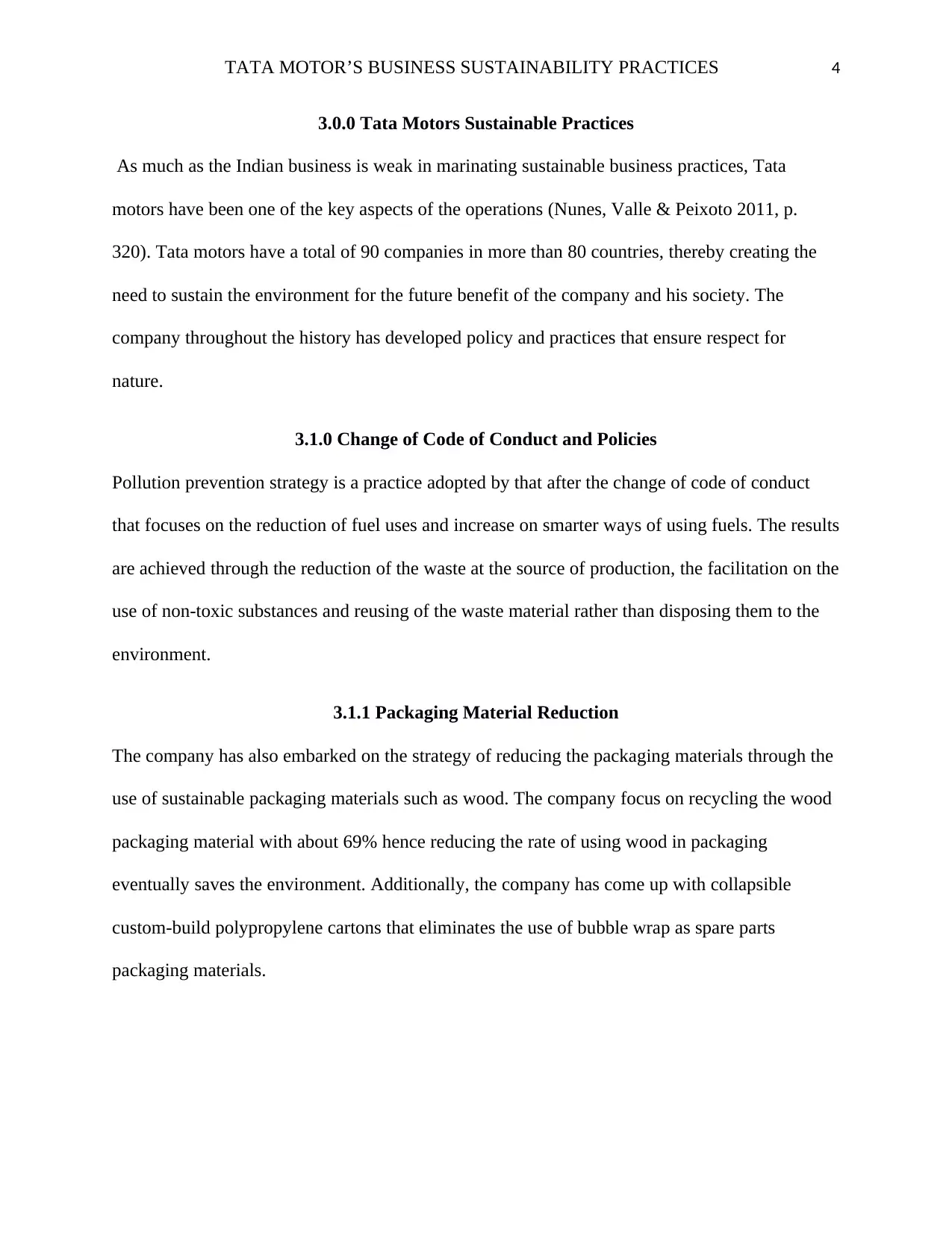
TATA MOTOR’S BUSINESS SUSTAINABILITY PRACTICES 4
3.0.0 Tata Motors Sustainable Practices
As much as the Indian business is weak in marinating sustainable business practices, Tata
motors have been one of the key aspects of the operations (Nunes, Valle & Peixoto 2011, p.
320). Tata motors have a total of 90 companies in more than 80 countries, thereby creating the
need to sustain the environment for the future benefit of the company and his society. The
company throughout the history has developed policy and practices that ensure respect for
nature.
3.1.0 Change of Code of Conduct and Policies
Pollution prevention strategy is a practice adopted by that after the change of code of conduct
that focuses on the reduction of fuel uses and increase on smarter ways of using fuels. The results
are achieved through the reduction of the waste at the source of production, the facilitation on the
use of non-toxic substances and reusing of the waste material rather than disposing them to the
environment.
3.1.1 Packaging Material Reduction
The company has also embarked on the strategy of reducing the packaging materials through the
use of sustainable packaging materials such as wood. The company focus on recycling the wood
packaging material with about 69% hence reducing the rate of using wood in packaging
eventually saves the environment. Additionally, the company has come up with collapsible
custom-build polypropylene cartons that eliminates the use of bubble wrap as spare parts
packaging materials.
3.0.0 Tata Motors Sustainable Practices
As much as the Indian business is weak in marinating sustainable business practices, Tata
motors have been one of the key aspects of the operations (Nunes, Valle & Peixoto 2011, p.
320). Tata motors have a total of 90 companies in more than 80 countries, thereby creating the
need to sustain the environment for the future benefit of the company and his society. The
company throughout the history has developed policy and practices that ensure respect for
nature.
3.1.0 Change of Code of Conduct and Policies
Pollution prevention strategy is a practice adopted by that after the change of code of conduct
that focuses on the reduction of fuel uses and increase on smarter ways of using fuels. The results
are achieved through the reduction of the waste at the source of production, the facilitation on the
use of non-toxic substances and reusing of the waste material rather than disposing them to the
environment.
3.1.1 Packaging Material Reduction
The company has also embarked on the strategy of reducing the packaging materials through the
use of sustainable packaging materials such as wood. The company focus on recycling the wood
packaging material with about 69% hence reducing the rate of using wood in packaging
eventually saves the environment. Additionally, the company has come up with collapsible
custom-build polypropylene cartons that eliminates the use of bubble wrap as spare parts
packaging materials.
Secure Best Marks with AI Grader
Need help grading? Try our AI Grader for instant feedback on your assignments.
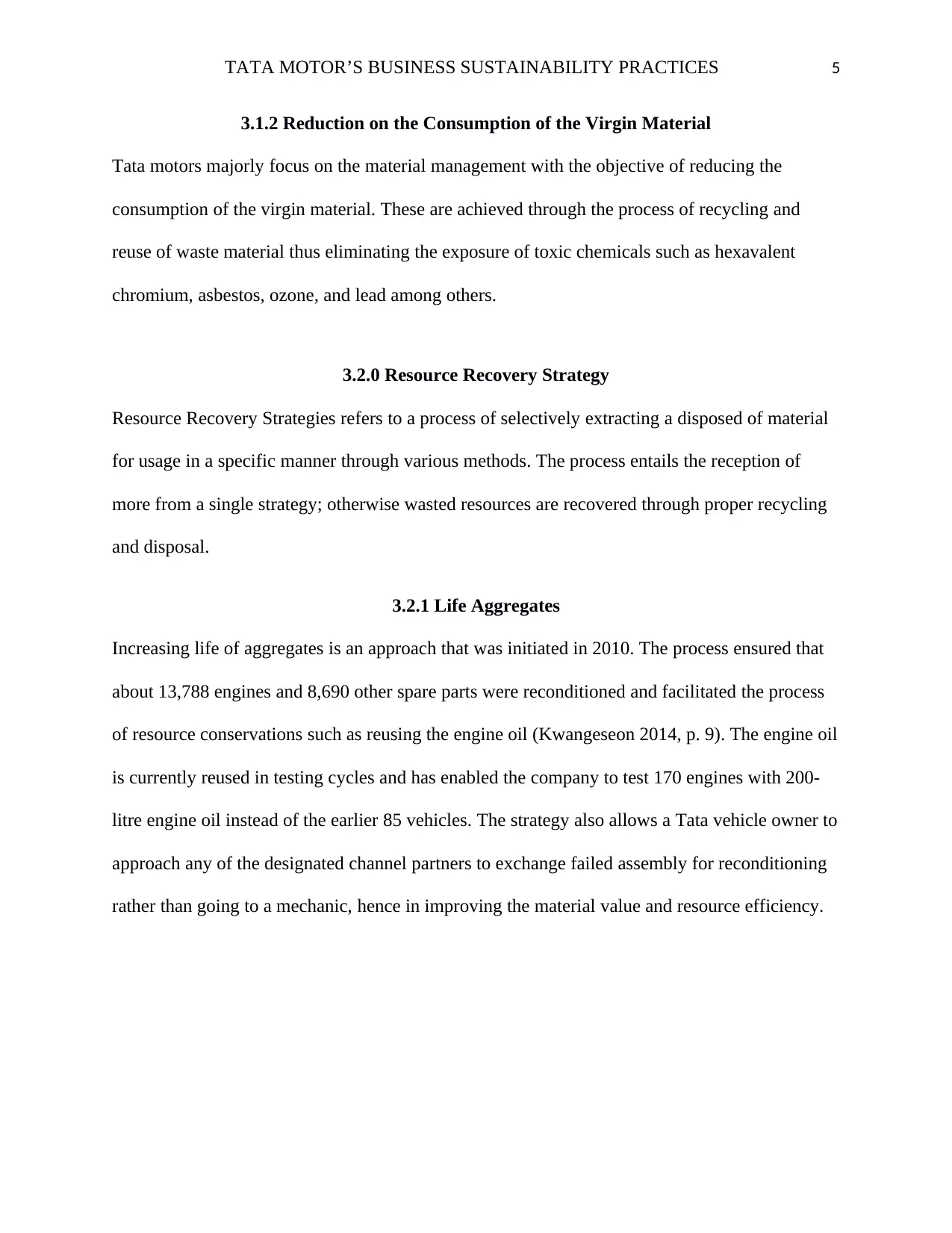
TATA MOTOR’S BUSINESS SUSTAINABILITY PRACTICES 5
3.1.2 Reduction on the Consumption of the Virgin Material
Tata motors majorly focus on the material management with the objective of reducing the
consumption of the virgin material. These are achieved through the process of recycling and
reuse of waste material thus eliminating the exposure of toxic chemicals such as hexavalent
chromium, asbestos, ozone, and lead among others.
3.2.0 Resource Recovery Strategy
Resource Recovery Strategies refers to a process of selectively extracting a disposed of material
for usage in a specific manner through various methods. The process entails the reception of
more from a single strategy; otherwise wasted resources are recovered through proper recycling
and disposal.
3.2.1 Life Aggregates
Increasing life of aggregates is an approach that was initiated in 2010. The process ensured that
about 13,788 engines and 8,690 other spare parts were reconditioned and facilitated the process
of resource conservations such as reusing the engine oil (Kwangeseon 2014, p. 9). The engine oil
is currently reused in testing cycles and has enabled the company to test 170 engines with 200-
litre engine oil instead of the earlier 85 vehicles. The strategy also allows a Tata vehicle owner to
approach any of the designated channel partners to exchange failed assembly for reconditioning
rather than going to a mechanic, hence in improving the material value and resource efficiency.
3.1.2 Reduction on the Consumption of the Virgin Material
Tata motors majorly focus on the material management with the objective of reducing the
consumption of the virgin material. These are achieved through the process of recycling and
reuse of waste material thus eliminating the exposure of toxic chemicals such as hexavalent
chromium, asbestos, ozone, and lead among others.
3.2.0 Resource Recovery Strategy
Resource Recovery Strategies refers to a process of selectively extracting a disposed of material
for usage in a specific manner through various methods. The process entails the reception of
more from a single strategy; otherwise wasted resources are recovered through proper recycling
and disposal.
3.2.1 Life Aggregates
Increasing life of aggregates is an approach that was initiated in 2010. The process ensured that
about 13,788 engines and 8,690 other spare parts were reconditioned and facilitated the process
of resource conservations such as reusing the engine oil (Kwangeseon 2014, p. 9). The engine oil
is currently reused in testing cycles and has enabled the company to test 170 engines with 200-
litre engine oil instead of the earlier 85 vehicles. The strategy also allows a Tata vehicle owner to
approach any of the designated channel partners to exchange failed assembly for reconditioning
rather than going to a mechanic, hence in improving the material value and resource efficiency.
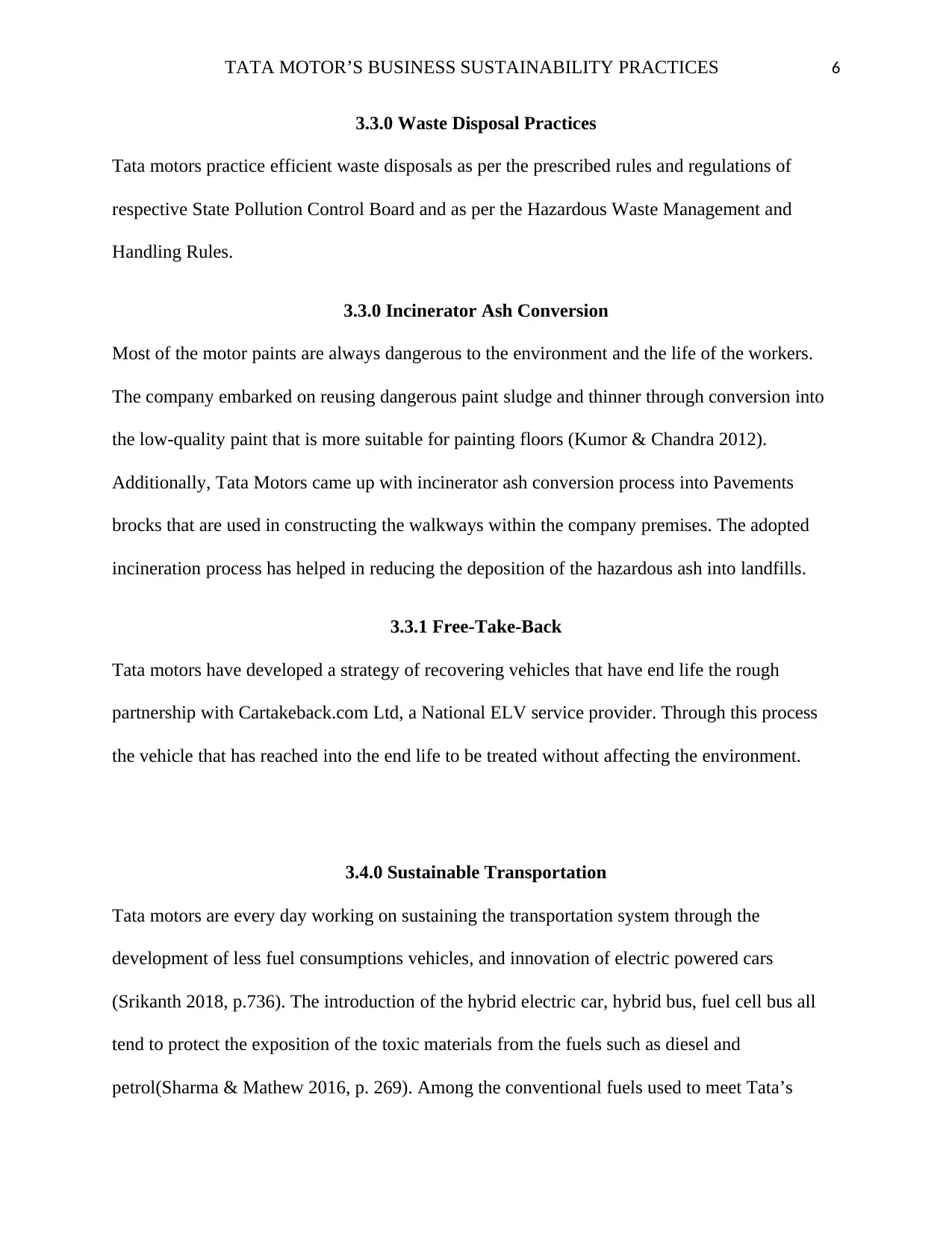
TATA MOTOR’S BUSINESS SUSTAINABILITY PRACTICES 6
3.3.0 Waste Disposal Practices
Tata motors practice efficient waste disposals as per the prescribed rules and regulations of
respective State Pollution Control Board and as per the Hazardous Waste Management and
Handling Rules.
3.3.0 Incinerator Ash Conversion
Most of the motor paints are always dangerous to the environment and the life of the workers.
The company embarked on reusing dangerous paint sludge and thinner through conversion into
the low-quality paint that is more suitable for painting floors (Kumor & Chandra 2012).
Additionally, Tata Motors came up with incinerator ash conversion process into Pavements
brocks that are used in constructing the walkways within the company premises. The adopted
incineration process has helped in reducing the deposition of the hazardous ash into landfills.
3.3.1 Free-Take-Back
Tata motors have developed a strategy of recovering vehicles that have end life the rough
partnership with Cartakeback.com Ltd, a National ELV service provider. Through this process
the vehicle that has reached into the end life to be treated without affecting the environment.
3.4.0 Sustainable Transportation
Tata motors are every day working on sustaining the transportation system through the
development of less fuel consumptions vehicles, and innovation of electric powered cars
(Srikanth 2018, p.736). The introduction of the hybrid electric car, hybrid bus, fuel cell bus all
tend to protect the exposition of the toxic materials from the fuels such as diesel and
petrol(Sharma & Mathew 2016, p. 269). Among the conventional fuels used to meet Tata’s
3.3.0 Waste Disposal Practices
Tata motors practice efficient waste disposals as per the prescribed rules and regulations of
respective State Pollution Control Board and as per the Hazardous Waste Management and
Handling Rules.
3.3.0 Incinerator Ash Conversion
Most of the motor paints are always dangerous to the environment and the life of the workers.
The company embarked on reusing dangerous paint sludge and thinner through conversion into
the low-quality paint that is more suitable for painting floors (Kumor & Chandra 2012).
Additionally, Tata Motors came up with incinerator ash conversion process into Pavements
brocks that are used in constructing the walkways within the company premises. The adopted
incineration process has helped in reducing the deposition of the hazardous ash into landfills.
3.3.1 Free-Take-Back
Tata motors have developed a strategy of recovering vehicles that have end life the rough
partnership with Cartakeback.com Ltd, a National ELV service provider. Through this process
the vehicle that has reached into the end life to be treated without affecting the environment.
3.4.0 Sustainable Transportation
Tata motors are every day working on sustaining the transportation system through the
development of less fuel consumptions vehicles, and innovation of electric powered cars
(Srikanth 2018, p.736). The introduction of the hybrid electric car, hybrid bus, fuel cell bus all
tend to protect the exposition of the toxic materials from the fuels such as diesel and
petrol(Sharma & Mathew 2016, p. 269). Among the conventional fuels used to meet Tata’s
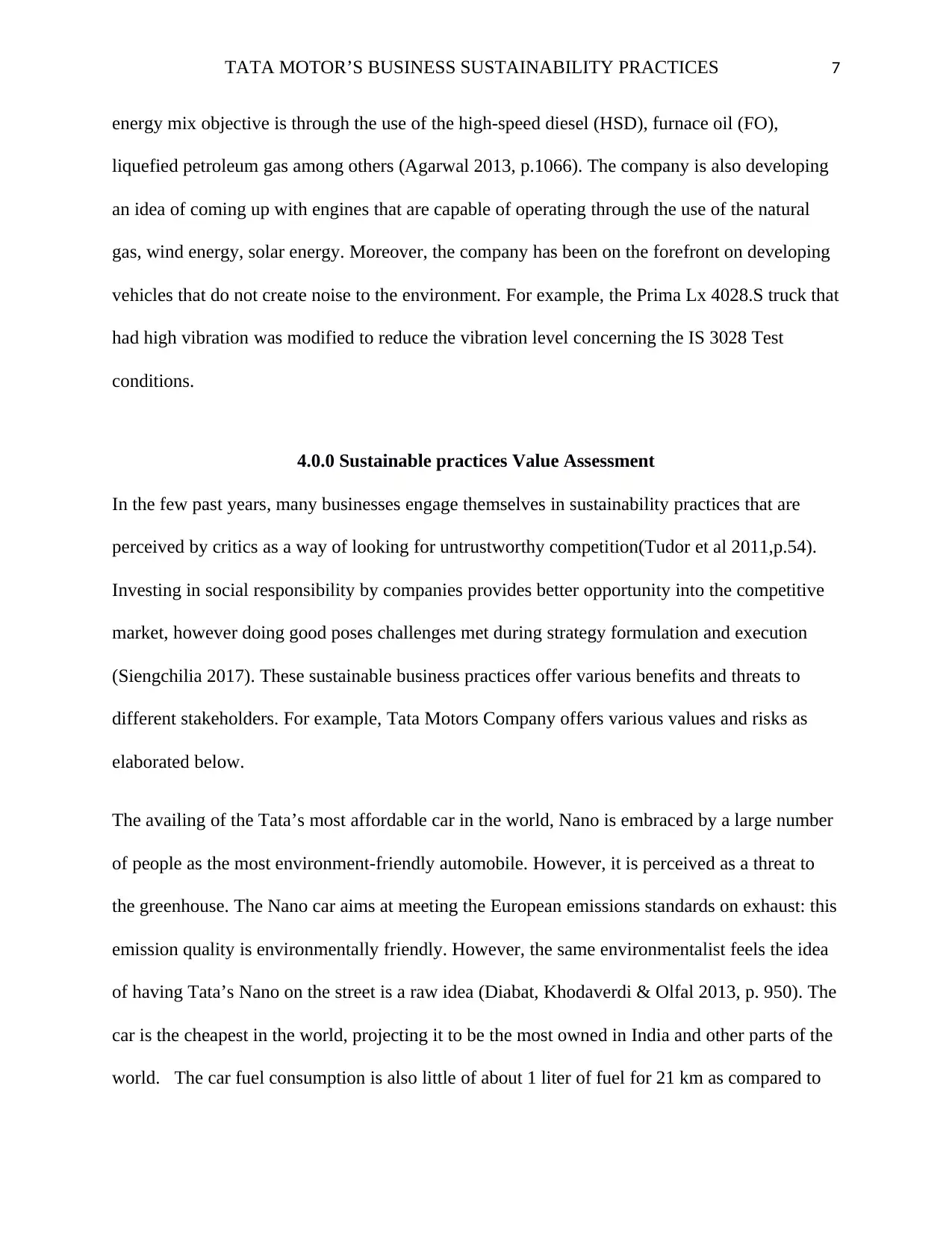
TATA MOTOR’S BUSINESS SUSTAINABILITY PRACTICES 7
energy mix objective is through the use of the high-speed diesel (HSD), furnace oil (FO),
liquefied petroleum gas among others (Agarwal 2013, p.1066). The company is also developing
an idea of coming up with engines that are capable of operating through the use of the natural
gas, wind energy, solar energy. Moreover, the company has been on the forefront on developing
vehicles that do not create noise to the environment. For example, the Prima Lx 4028.S truck that
had high vibration was modified to reduce the vibration level concerning the IS 3028 Test
conditions.
4.0.0 Sustainable practices Value Assessment
In the few past years, many businesses engage themselves in sustainability practices that are
perceived by critics as a way of looking for untrustworthy competition(Tudor et al 2011,p.54).
Investing in social responsibility by companies provides better opportunity into the competitive
market, however doing good poses challenges met during strategy formulation and execution
(Siengchilia 2017). These sustainable business practices offer various benefits and threats to
different stakeholders. For example, Tata Motors Company offers various values and risks as
elaborated below.
The availing of the Tata’s most affordable car in the world, Nano is embraced by a large number
of people as the most environment-friendly automobile. However, it is perceived as a threat to
the greenhouse. The Nano car aims at meeting the European emissions standards on exhaust: this
emission quality is environmentally friendly. However, the same environmentalist feels the idea
of having Tata’s Nano on the street is a raw idea (Diabat, Khodaverdi & Olfal 2013, p. 950). The
car is the cheapest in the world, projecting it to be the most owned in India and other parts of the
world. The car fuel consumption is also little of about 1 liter of fuel for 21 km as compared to
energy mix objective is through the use of the high-speed diesel (HSD), furnace oil (FO),
liquefied petroleum gas among others (Agarwal 2013, p.1066). The company is also developing
an idea of coming up with engines that are capable of operating through the use of the natural
gas, wind energy, solar energy. Moreover, the company has been on the forefront on developing
vehicles that do not create noise to the environment. For example, the Prima Lx 4028.S truck that
had high vibration was modified to reduce the vibration level concerning the IS 3028 Test
conditions.
4.0.0 Sustainable practices Value Assessment
In the few past years, many businesses engage themselves in sustainability practices that are
perceived by critics as a way of looking for untrustworthy competition(Tudor et al 2011,p.54).
Investing in social responsibility by companies provides better opportunity into the competitive
market, however doing good poses challenges met during strategy formulation and execution
(Siengchilia 2017). These sustainable business practices offer various benefits and threats to
different stakeholders. For example, Tata Motors Company offers various values and risks as
elaborated below.
The availing of the Tata’s most affordable car in the world, Nano is embraced by a large number
of people as the most environment-friendly automobile. However, it is perceived as a threat to
the greenhouse. The Nano car aims at meeting the European emissions standards on exhaust: this
emission quality is environmentally friendly. However, the same environmentalist feels the idea
of having Tata’s Nano on the street is a raw idea (Diabat, Khodaverdi & Olfal 2013, p. 950). The
car is the cheapest in the world, projecting it to be the most owned in India and other parts of the
world. The car fuel consumption is also little of about 1 liter of fuel for 21 km as compared to
Paraphrase This Document
Need a fresh take? Get an instant paraphrase of this document with our AI Paraphraser
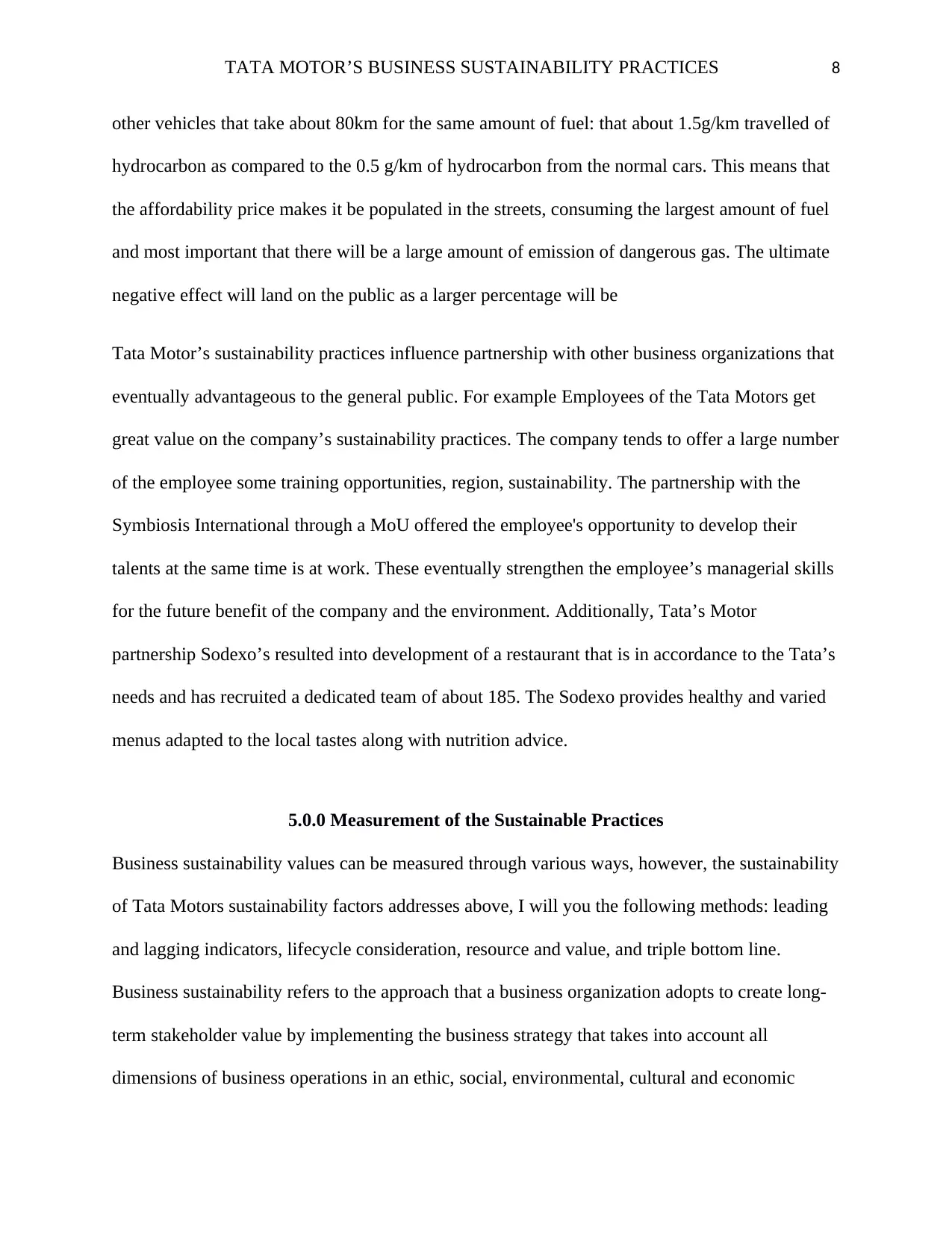
TATA MOTOR’S BUSINESS SUSTAINABILITY PRACTICES 8
other vehicles that take about 80km for the same amount of fuel: that about 1.5g/km travelled of
hydrocarbon as compared to the 0.5 g/km of hydrocarbon from the normal cars. This means that
the affordability price makes it be populated in the streets, consuming the largest amount of fuel
and most important that there will be a large amount of emission of dangerous gas. The ultimate
negative effect will land on the public as a larger percentage will be
Tata Motor’s sustainability practices influence partnership with other business organizations that
eventually advantageous to the general public. For example Employees of the Tata Motors get
great value on the company’s sustainability practices. The company tends to offer a large number
of the employee some training opportunities, region, sustainability. The partnership with the
Symbiosis International through a MoU offered the employee's opportunity to develop their
talents at the same time is at work. These eventually strengthen the employee’s managerial skills
for the future benefit of the company and the environment. Additionally, Tata’s Motor
partnership Sodexo’s resulted into development of a restaurant that is in accordance to the Tata’s
needs and has recruited a dedicated team of about 185. The Sodexo provides healthy and varied
menus adapted to the local tastes along with nutrition advice.
5.0.0 Measurement of the Sustainable Practices
Business sustainability values can be measured through various ways, however, the sustainability
of Tata Motors sustainability factors addresses above, I will you the following methods: leading
and lagging indicators, lifecycle consideration, resource and value, and triple bottom line.
Business sustainability refers to the approach that a business organization adopts to create long-
term stakeholder value by implementing the business strategy that takes into account all
dimensions of business operations in an ethic, social, environmental, cultural and economic
other vehicles that take about 80km for the same amount of fuel: that about 1.5g/km travelled of
hydrocarbon as compared to the 0.5 g/km of hydrocarbon from the normal cars. This means that
the affordability price makes it be populated in the streets, consuming the largest amount of fuel
and most important that there will be a large amount of emission of dangerous gas. The ultimate
negative effect will land on the public as a larger percentage will be
Tata Motor’s sustainability practices influence partnership with other business organizations that
eventually advantageous to the general public. For example Employees of the Tata Motors get
great value on the company’s sustainability practices. The company tends to offer a large number
of the employee some training opportunities, region, sustainability. The partnership with the
Symbiosis International through a MoU offered the employee's opportunity to develop their
talents at the same time is at work. These eventually strengthen the employee’s managerial skills
for the future benefit of the company and the environment. Additionally, Tata’s Motor
partnership Sodexo’s resulted into development of a restaurant that is in accordance to the Tata’s
needs and has recruited a dedicated team of about 185. The Sodexo provides healthy and varied
menus adapted to the local tastes along with nutrition advice.
5.0.0 Measurement of the Sustainable Practices
Business sustainability values can be measured through various ways, however, the sustainability
of Tata Motors sustainability factors addresses above, I will you the following methods: leading
and lagging indicators, lifecycle consideration, resource and value, and triple bottom line.
Business sustainability refers to the approach that a business organization adopts to create long-
term stakeholder value by implementing the business strategy that takes into account all
dimensions of business operations in an ethic, social, environmental, cultural and economic
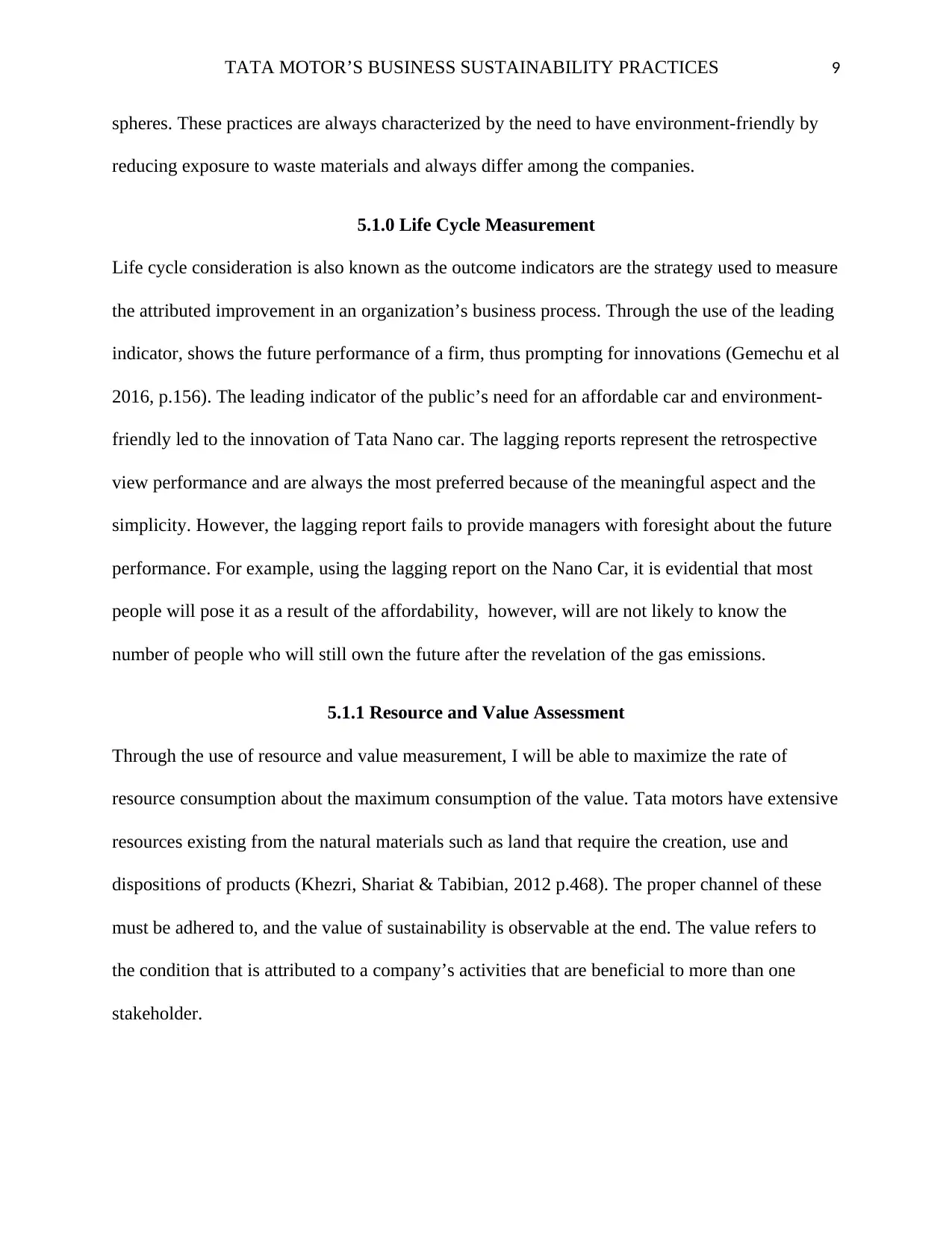
TATA MOTOR’S BUSINESS SUSTAINABILITY PRACTICES 9
spheres. These practices are always characterized by the need to have environment-friendly by
reducing exposure to waste materials and always differ among the companies.
5.1.0 Life Cycle Measurement
Life cycle consideration is also known as the outcome indicators are the strategy used to measure
the attributed improvement in an organization’s business process. Through the use of the leading
indicator, shows the future performance of a firm, thus prompting for innovations (Gemechu et al
2016, p.156). The leading indicator of the public’s need for an affordable car and environment-
friendly led to the innovation of Tata Nano car. The lagging reports represent the retrospective
view performance and are always the most preferred because of the meaningful aspect and the
simplicity. However, the lagging report fails to provide managers with foresight about the future
performance. For example, using the lagging report on the Nano Car, it is evidential that most
people will pose it as a result of the affordability, however, will are not likely to know the
number of people who will still own the future after the revelation of the gas emissions.
5.1.1 Resource and Value Assessment
Through the use of resource and value measurement, I will be able to maximize the rate of
resource consumption about the maximum consumption of the value. Tata motors have extensive
resources existing from the natural materials such as land that require the creation, use and
dispositions of products (Khezri, Shariat & Tabibian, 2012 p.468). The proper channel of these
must be adhered to, and the value of sustainability is observable at the end. The value refers to
the condition that is attributed to a company’s activities that are beneficial to more than one
stakeholder.
spheres. These practices are always characterized by the need to have environment-friendly by
reducing exposure to waste materials and always differ among the companies.
5.1.0 Life Cycle Measurement
Life cycle consideration is also known as the outcome indicators are the strategy used to measure
the attributed improvement in an organization’s business process. Through the use of the leading
indicator, shows the future performance of a firm, thus prompting for innovations (Gemechu et al
2016, p.156). The leading indicator of the public’s need for an affordable car and environment-
friendly led to the innovation of Tata Nano car. The lagging reports represent the retrospective
view performance and are always the most preferred because of the meaningful aspect and the
simplicity. However, the lagging report fails to provide managers with foresight about the future
performance. For example, using the lagging report on the Nano Car, it is evidential that most
people will pose it as a result of the affordability, however, will are not likely to know the
number of people who will still own the future after the revelation of the gas emissions.
5.1.1 Resource and Value Assessment
Through the use of resource and value measurement, I will be able to maximize the rate of
resource consumption about the maximum consumption of the value. Tata motors have extensive
resources existing from the natural materials such as land that require the creation, use and
dispositions of products (Khezri, Shariat & Tabibian, 2012 p.468). The proper channel of these
must be adhered to, and the value of sustainability is observable at the end. The value refers to
the condition that is attributed to a company’s activities that are beneficial to more than one
stakeholder.
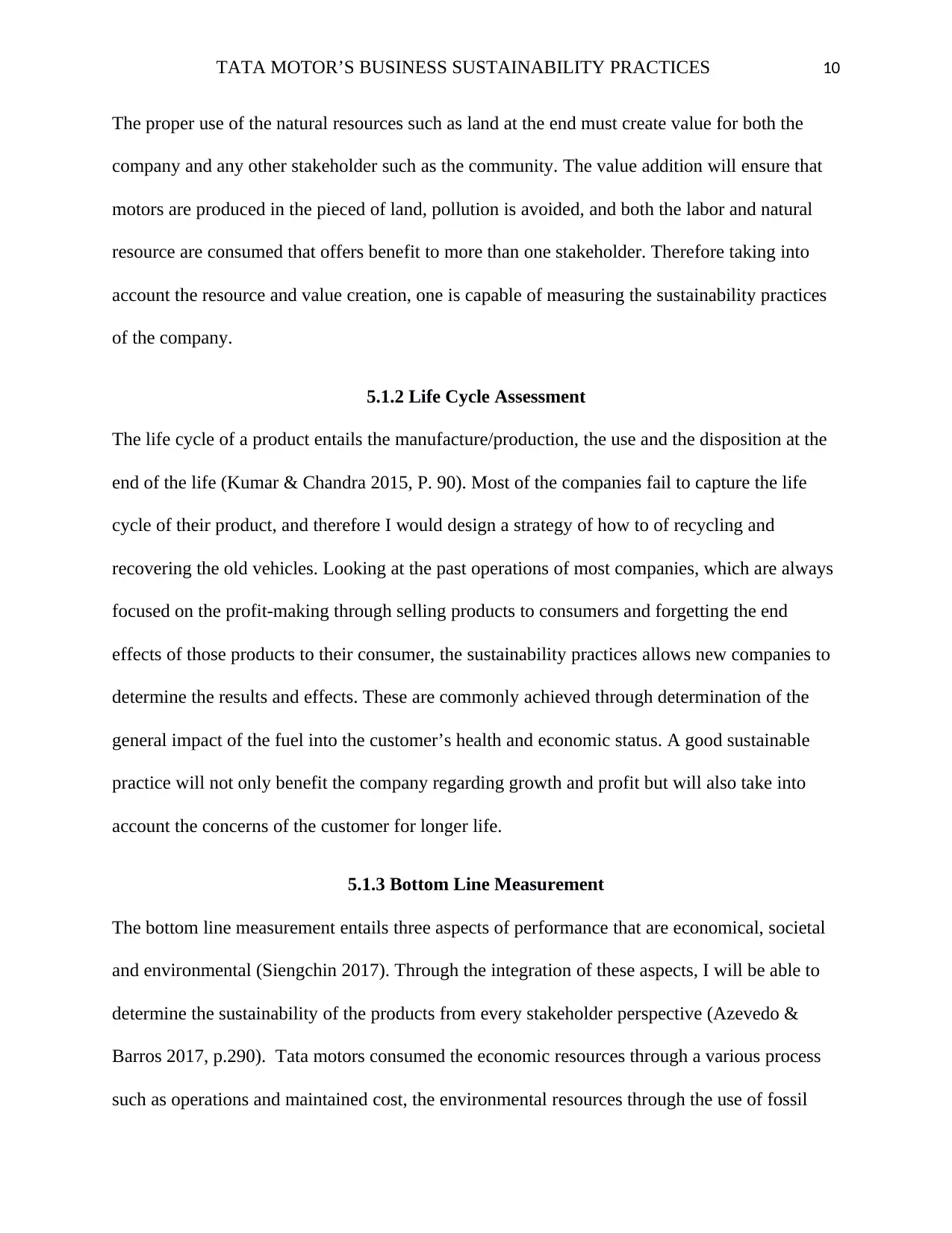
TATA MOTOR’S BUSINESS SUSTAINABILITY PRACTICES 10
The proper use of the natural resources such as land at the end must create value for both the
company and any other stakeholder such as the community. The value addition will ensure that
motors are produced in the pieced of land, pollution is avoided, and both the labor and natural
resource are consumed that offers benefit to more than one stakeholder. Therefore taking into
account the resource and value creation, one is capable of measuring the sustainability practices
of the company.
5.1.2 Life Cycle Assessment
The life cycle of a product entails the manufacture/production, the use and the disposition at the
end of the life (Kumar & Chandra 2015, P. 90). Most of the companies fail to capture the life
cycle of their product, and therefore I would design a strategy of how to of recycling and
recovering the old vehicles. Looking at the past operations of most companies, which are always
focused on the profit-making through selling products to consumers and forgetting the end
effects of those products to their consumer, the sustainability practices allows new companies to
determine the results and effects. These are commonly achieved through determination of the
general impact of the fuel into the customer’s health and economic status. A good sustainable
practice will not only benefit the company regarding growth and profit but will also take into
account the concerns of the customer for longer life.
5.1.3 Bottom Line Measurement
The bottom line measurement entails three aspects of performance that are economical, societal
and environmental (Siengchin 2017). Through the integration of these aspects, I will be able to
determine the sustainability of the products from every stakeholder perspective (Azevedo &
Barros 2017, p.290). Tata motors consumed the economic resources through a various process
such as operations and maintained cost, the environmental resources through the use of fossil
The proper use of the natural resources such as land at the end must create value for both the
company and any other stakeholder such as the community. The value addition will ensure that
motors are produced in the pieced of land, pollution is avoided, and both the labor and natural
resource are consumed that offers benefit to more than one stakeholder. Therefore taking into
account the resource and value creation, one is capable of measuring the sustainability practices
of the company.
5.1.2 Life Cycle Assessment
The life cycle of a product entails the manufacture/production, the use and the disposition at the
end of the life (Kumar & Chandra 2015, P. 90). Most of the companies fail to capture the life
cycle of their product, and therefore I would design a strategy of how to of recycling and
recovering the old vehicles. Looking at the past operations of most companies, which are always
focused on the profit-making through selling products to consumers and forgetting the end
effects of those products to their consumer, the sustainability practices allows new companies to
determine the results and effects. These are commonly achieved through determination of the
general impact of the fuel into the customer’s health and economic status. A good sustainable
practice will not only benefit the company regarding growth and profit but will also take into
account the concerns of the customer for longer life.
5.1.3 Bottom Line Measurement
The bottom line measurement entails three aspects of performance that are economical, societal
and environmental (Siengchin 2017). Through the integration of these aspects, I will be able to
determine the sustainability of the products from every stakeholder perspective (Azevedo &
Barros 2017, p.290). Tata motors consumed the economic resources through a various process
such as operations and maintained cost, the environmental resources through the use of fossil
Secure Best Marks with AI Grader
Need help grading? Try our AI Grader for instant feedback on your assignments.
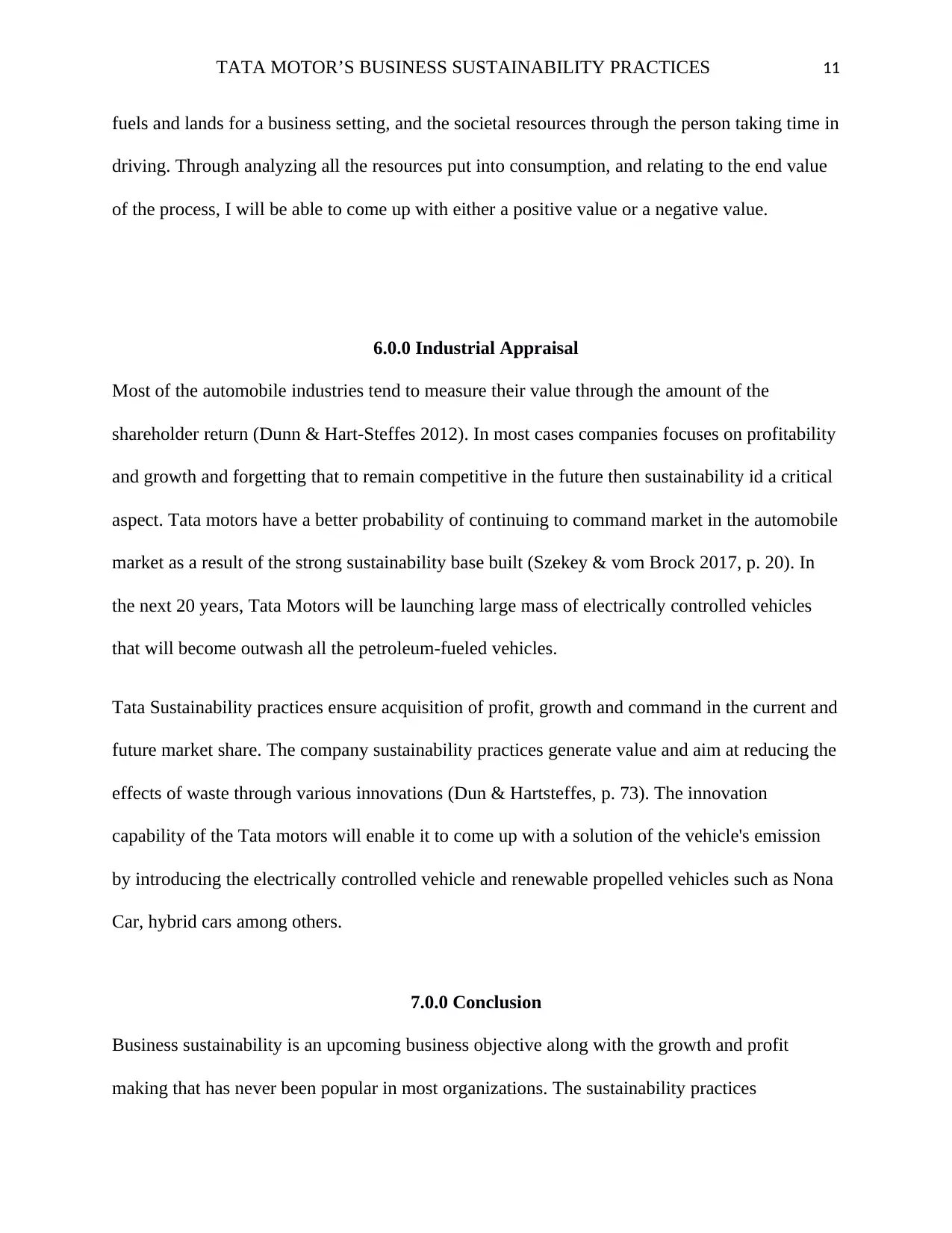
TATA MOTOR’S BUSINESS SUSTAINABILITY PRACTICES 11
fuels and lands for a business setting, and the societal resources through the person taking time in
driving. Through analyzing all the resources put into consumption, and relating to the end value
of the process, I will be able to come up with either a positive value or a negative value.
6.0.0 Industrial Appraisal
Most of the automobile industries tend to measure their value through the amount of the
shareholder return (Dunn & Hart-Steffes 2012). In most cases companies focuses on profitability
and growth and forgetting that to remain competitive in the future then sustainability id a critical
aspect. Tata motors have a better probability of continuing to command market in the automobile
market as a result of the strong sustainability base built (Szekey & vom Brock 2017, p. 20). In
the next 20 years, Tata Motors will be launching large mass of electrically controlled vehicles
that will become outwash all the petroleum-fueled vehicles.
Tata Sustainability practices ensure acquisition of profit, growth and command in the current and
future market share. The company sustainability practices generate value and aim at reducing the
effects of waste through various innovations (Dun & Hartsteffes, p. 73). The innovation
capability of the Tata motors will enable it to come up with a solution of the vehicle's emission
by introducing the electrically controlled vehicle and renewable propelled vehicles such as Nona
Car, hybrid cars among others.
7.0.0 Conclusion
Business sustainability is an upcoming business objective along with the growth and profit
making that has never been popular in most organizations. The sustainability practices
fuels and lands for a business setting, and the societal resources through the person taking time in
driving. Through analyzing all the resources put into consumption, and relating to the end value
of the process, I will be able to come up with either a positive value or a negative value.
6.0.0 Industrial Appraisal
Most of the automobile industries tend to measure their value through the amount of the
shareholder return (Dunn & Hart-Steffes 2012). In most cases companies focuses on profitability
and growth and forgetting that to remain competitive in the future then sustainability id a critical
aspect. Tata motors have a better probability of continuing to command market in the automobile
market as a result of the strong sustainability base built (Szekey & vom Brock 2017, p. 20). In
the next 20 years, Tata Motors will be launching large mass of electrically controlled vehicles
that will become outwash all the petroleum-fueled vehicles.
Tata Sustainability practices ensure acquisition of profit, growth and command in the current and
future market share. The company sustainability practices generate value and aim at reducing the
effects of waste through various innovations (Dun & Hartsteffes, p. 73). The innovation
capability of the Tata motors will enable it to come up with a solution of the vehicle's emission
by introducing the electrically controlled vehicle and renewable propelled vehicles such as Nona
Car, hybrid cars among others.
7.0.0 Conclusion
Business sustainability is an upcoming business objective along with the growth and profit
making that has never been popular in most organizations. The sustainability practices
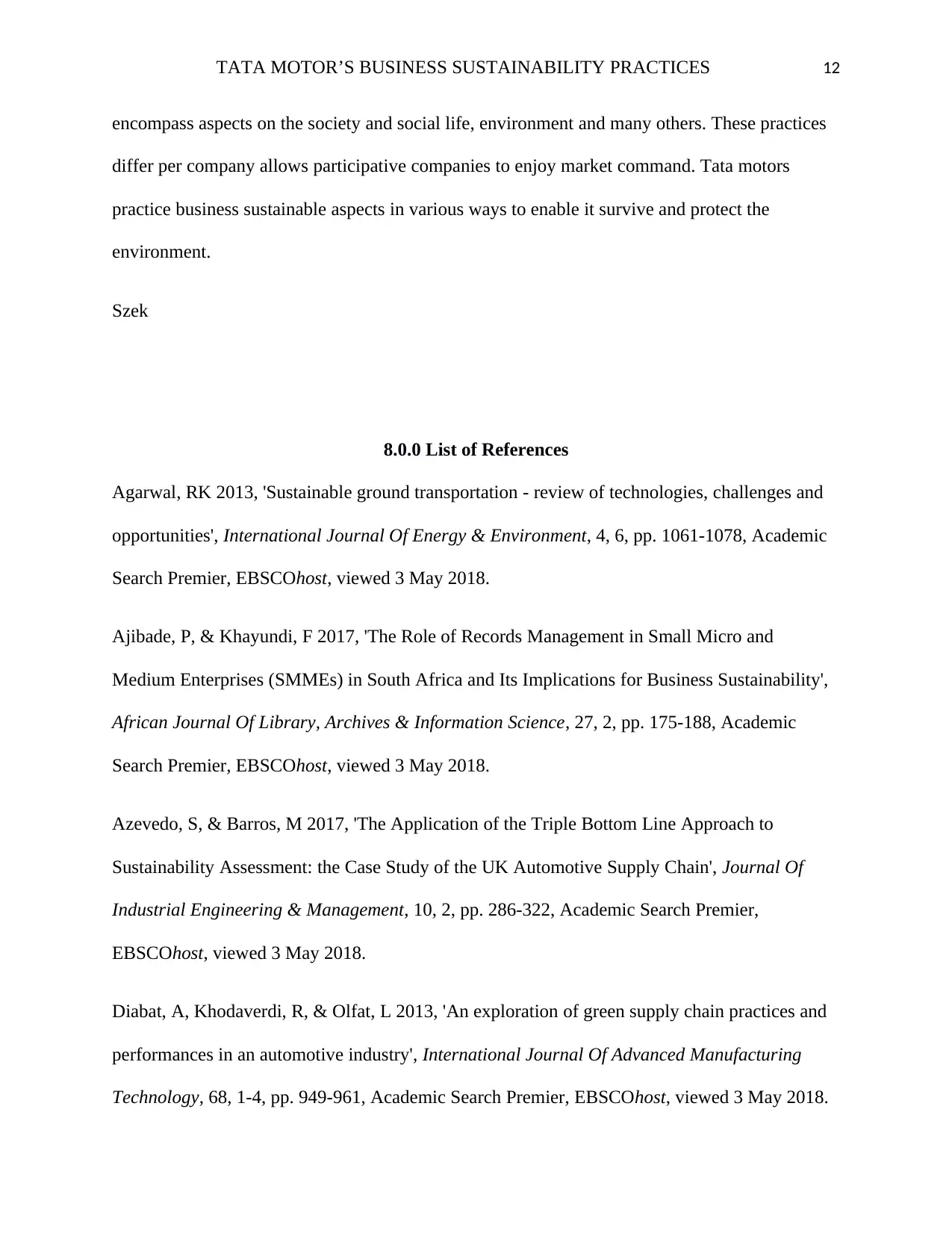
TATA MOTOR’S BUSINESS SUSTAINABILITY PRACTICES 12
encompass aspects on the society and social life, environment and many others. These practices
differ per company allows participative companies to enjoy market command. Tata motors
practice business sustainable aspects in various ways to enable it survive and protect the
environment.
Szek
8.0.0 List of References
Agarwal, RK 2013, 'Sustainable ground transportation - review of technologies, challenges and
opportunities', International Journal Of Energy & Environment, 4, 6, pp. 1061-1078, Academic
Search Premier, EBSCOhost, viewed 3 May 2018.
Ajibade, P, & Khayundi, F 2017, 'The Role of Records Management in Small Micro and
Medium Enterprises (SMMEs) in South Africa and Its Implications for Business Sustainability',
African Journal Of Library, Archives & Information Science, 27, 2, pp. 175-188, Academic
Search Premier, EBSCOhost, viewed 3 May 2018.
Azevedo, S, & Barros, M 2017, 'The Application of the Triple Bottom Line Approach to
Sustainability Assessment: the Case Study of the UK Automotive Supply Chain', Journal Of
Industrial Engineering & Management, 10, 2, pp. 286-322, Academic Search Premier,
EBSCOhost, viewed 3 May 2018.
Diabat, A, Khodaverdi, R, & Olfat, L 2013, 'An exploration of green supply chain practices and
performances in an automotive industry', International Journal Of Advanced Manufacturing
Technology, 68, 1-4, pp. 949-961, Academic Search Premier, EBSCOhost, viewed 3 May 2018.
encompass aspects on the society and social life, environment and many others. These practices
differ per company allows participative companies to enjoy market command. Tata motors
practice business sustainable aspects in various ways to enable it survive and protect the
environment.
Szek
8.0.0 List of References
Agarwal, RK 2013, 'Sustainable ground transportation - review of technologies, challenges and
opportunities', International Journal Of Energy & Environment, 4, 6, pp. 1061-1078, Academic
Search Premier, EBSCOhost, viewed 3 May 2018.
Ajibade, P, & Khayundi, F 2017, 'The Role of Records Management in Small Micro and
Medium Enterprises (SMMEs) in South Africa and Its Implications for Business Sustainability',
African Journal Of Library, Archives & Information Science, 27, 2, pp. 175-188, Academic
Search Premier, EBSCOhost, viewed 3 May 2018.
Azevedo, S, & Barros, M 2017, 'The Application of the Triple Bottom Line Approach to
Sustainability Assessment: the Case Study of the UK Automotive Supply Chain', Journal Of
Industrial Engineering & Management, 10, 2, pp. 286-322, Academic Search Premier,
EBSCOhost, viewed 3 May 2018.
Diabat, A, Khodaverdi, R, & Olfat, L 2013, 'An exploration of green supply chain practices and
performances in an automotive industry', International Journal Of Advanced Manufacturing
Technology, 68, 1-4, pp. 949-961, Academic Search Premier, EBSCOhost, viewed 3 May 2018.
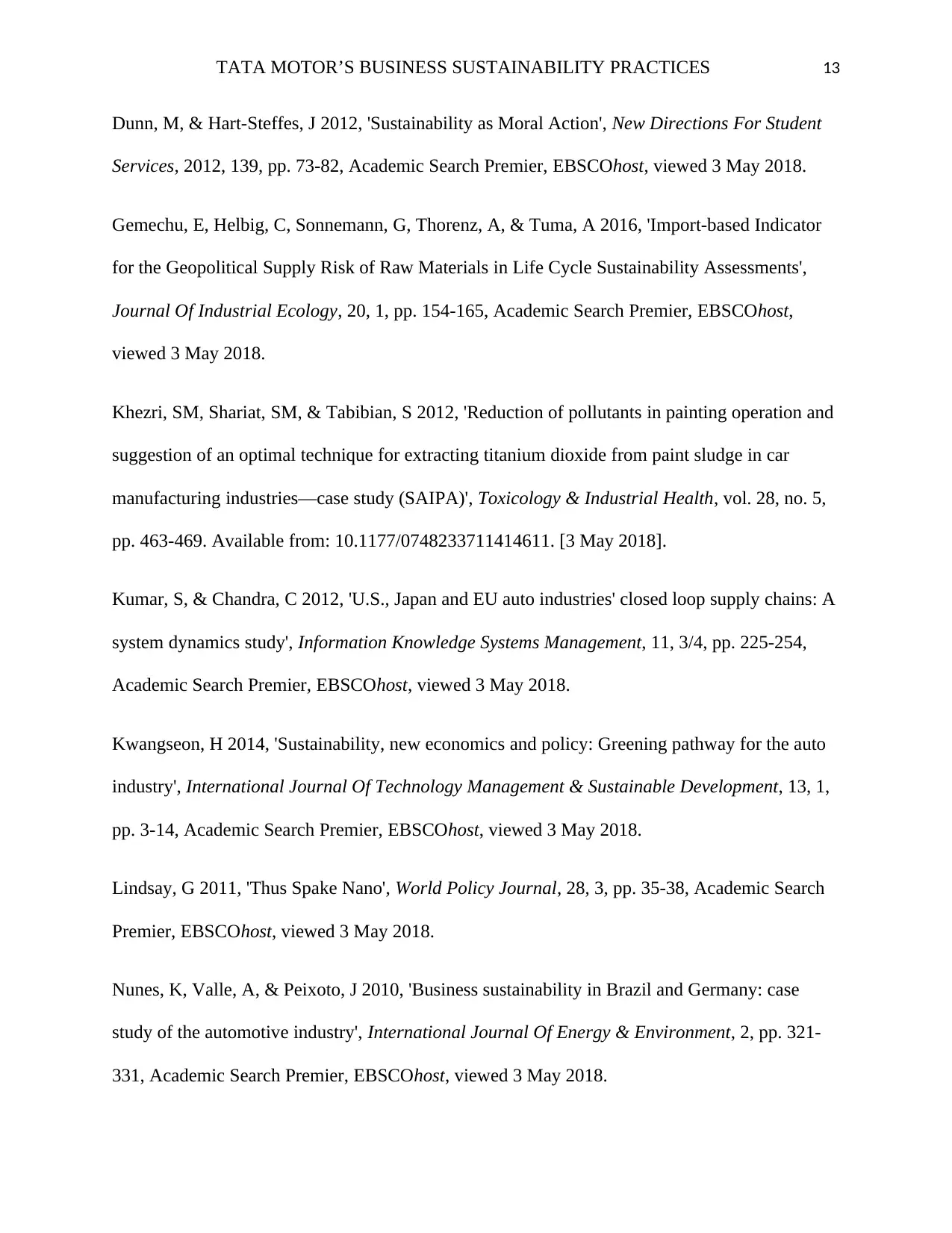
TATA MOTOR’S BUSINESS SUSTAINABILITY PRACTICES 13
Dunn, M, & Hart-Steffes, J 2012, 'Sustainability as Moral Action', New Directions For Student
Services, 2012, 139, pp. 73-82, Academic Search Premier, EBSCOhost, viewed 3 May 2018.
Gemechu, E, Helbig, C, Sonnemann, G, Thorenz, A, & Tuma, A 2016, 'Import-based Indicator
for the Geopolitical Supply Risk of Raw Materials in Life Cycle Sustainability Assessments',
Journal Of Industrial Ecology, 20, 1, pp. 154-165, Academic Search Premier, EBSCOhost,
viewed 3 May 2018.
Khezri, SM, Shariat, SM, & Tabibian, S 2012, 'Reduction of pollutants in painting operation and
suggestion of an optimal technique for extracting titanium dioxide from paint sludge in car
manufacturing industries—case study (SAIPA)', Toxicology & Industrial Health, vol. 28, no. 5,
pp. 463-469. Available from: 10.1177/0748233711414611. [3 May 2018].
Kumar, S, & Chandra, C 2012, 'U.S., Japan and EU auto industries' closed loop supply chains: A
system dynamics study', Information Knowledge Systems Management, 11, 3/4, pp. 225-254,
Academic Search Premier, EBSCOhost, viewed 3 May 2018.
Kwangseon, H 2014, 'Sustainability, new economics and policy: Greening pathway for the auto
industry', International Journal Of Technology Management & Sustainable Development, 13, 1,
pp. 3-14, Academic Search Premier, EBSCOhost, viewed 3 May 2018.
Lindsay, G 2011, 'Thus Spake Nano', World Policy Journal, 28, 3, pp. 35-38, Academic Search
Premier, EBSCOhost, viewed 3 May 2018.
Nunes, K, Valle, A, & Peixoto, J 2010, 'Business sustainability in Brazil and Germany: case
study of the automotive industry', International Journal Of Energy & Environment, 2, pp. 321-
331, Academic Search Premier, EBSCOhost, viewed 3 May 2018.
Dunn, M, & Hart-Steffes, J 2012, 'Sustainability as Moral Action', New Directions For Student
Services, 2012, 139, pp. 73-82, Academic Search Premier, EBSCOhost, viewed 3 May 2018.
Gemechu, E, Helbig, C, Sonnemann, G, Thorenz, A, & Tuma, A 2016, 'Import-based Indicator
for the Geopolitical Supply Risk of Raw Materials in Life Cycle Sustainability Assessments',
Journal Of Industrial Ecology, 20, 1, pp. 154-165, Academic Search Premier, EBSCOhost,
viewed 3 May 2018.
Khezri, SM, Shariat, SM, & Tabibian, S 2012, 'Reduction of pollutants in painting operation and
suggestion of an optimal technique for extracting titanium dioxide from paint sludge in car
manufacturing industries—case study (SAIPA)', Toxicology & Industrial Health, vol. 28, no. 5,
pp. 463-469. Available from: 10.1177/0748233711414611. [3 May 2018].
Kumar, S, & Chandra, C 2012, 'U.S., Japan and EU auto industries' closed loop supply chains: A
system dynamics study', Information Knowledge Systems Management, 11, 3/4, pp. 225-254,
Academic Search Premier, EBSCOhost, viewed 3 May 2018.
Kwangseon, H 2014, 'Sustainability, new economics and policy: Greening pathway for the auto
industry', International Journal Of Technology Management & Sustainable Development, 13, 1,
pp. 3-14, Academic Search Premier, EBSCOhost, viewed 3 May 2018.
Lindsay, G 2011, 'Thus Spake Nano', World Policy Journal, 28, 3, pp. 35-38, Academic Search
Premier, EBSCOhost, viewed 3 May 2018.
Nunes, K, Valle, A, & Peixoto, J 2010, 'Business sustainability in Brazil and Germany: case
study of the automotive industry', International Journal Of Energy & Environment, 2, pp. 321-
331, Academic Search Premier, EBSCOhost, viewed 3 May 2018.
Paraphrase This Document
Need a fresh take? Get an instant paraphrase of this document with our AI Paraphraser
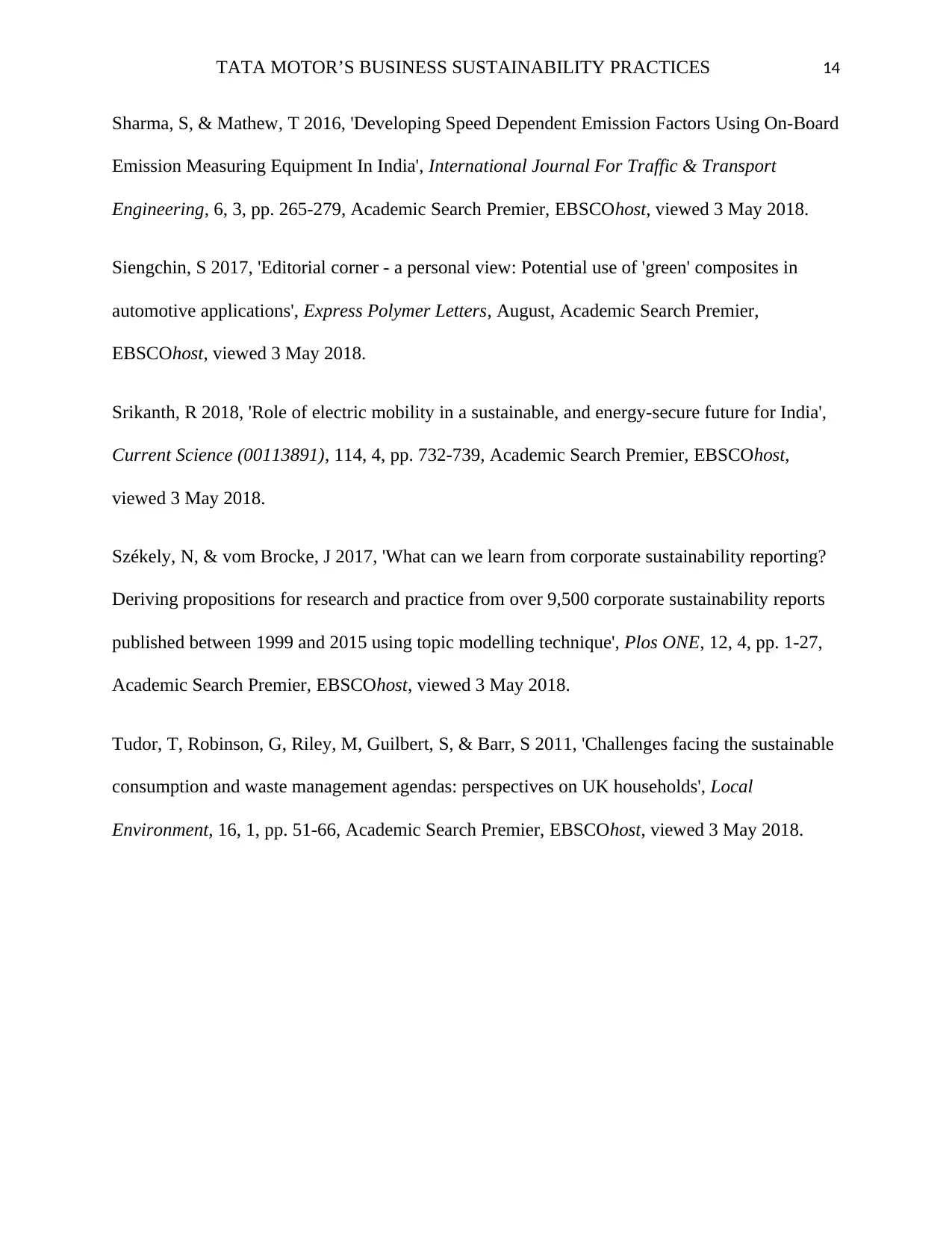
TATA MOTOR’S BUSINESS SUSTAINABILITY PRACTICES 14
Sharma, S, & Mathew, T 2016, 'Developing Speed Dependent Emission Factors Using On-Board
Emission Measuring Equipment In India', International Journal For Traffic & Transport
Engineering, 6, 3, pp. 265-279, Academic Search Premier, EBSCOhost, viewed 3 May 2018.
Siengchin, S 2017, 'Editorial corner - a personal view: Potential use of 'green' composites in
automotive applications', Express Polymer Letters, August, Academic Search Premier,
EBSCOhost, viewed 3 May 2018.
Srikanth, R 2018, 'Role of electric mobility in a sustainable, and energy-secure future for India',
Current Science (00113891), 114, 4, pp. 732-739, Academic Search Premier, EBSCOhost,
viewed 3 May 2018.
Székely, N, & vom Brocke, J 2017, 'What can we learn from corporate sustainability reporting?
Deriving propositions for research and practice from over 9,500 corporate sustainability reports
published between 1999 and 2015 using topic modelling technique', Plos ONE, 12, 4, pp. 1-27,
Academic Search Premier, EBSCOhost, viewed 3 May 2018.
Tudor, T, Robinson, G, Riley, M, Guilbert, S, & Barr, S 2011, 'Challenges facing the sustainable
consumption and waste management agendas: perspectives on UK households', Local
Environment, 16, 1, pp. 51-66, Academic Search Premier, EBSCOhost, viewed 3 May 2018.
Sharma, S, & Mathew, T 2016, 'Developing Speed Dependent Emission Factors Using On-Board
Emission Measuring Equipment In India', International Journal For Traffic & Transport
Engineering, 6, 3, pp. 265-279, Academic Search Premier, EBSCOhost, viewed 3 May 2018.
Siengchin, S 2017, 'Editorial corner - a personal view: Potential use of 'green' composites in
automotive applications', Express Polymer Letters, August, Academic Search Premier,
EBSCOhost, viewed 3 May 2018.
Srikanth, R 2018, 'Role of electric mobility in a sustainable, and energy-secure future for India',
Current Science (00113891), 114, 4, pp. 732-739, Academic Search Premier, EBSCOhost,
viewed 3 May 2018.
Székely, N, & vom Brocke, J 2017, 'What can we learn from corporate sustainability reporting?
Deriving propositions for research and practice from over 9,500 corporate sustainability reports
published between 1999 and 2015 using topic modelling technique', Plos ONE, 12, 4, pp. 1-27,
Academic Search Premier, EBSCOhost, viewed 3 May 2018.
Tudor, T, Robinson, G, Riley, M, Guilbert, S, & Barr, S 2011, 'Challenges facing the sustainable
consumption and waste management agendas: perspectives on UK households', Local
Environment, 16, 1, pp. 51-66, Academic Search Premier, EBSCOhost, viewed 3 May 2018.
1 out of 14
Related Documents
Your All-in-One AI-Powered Toolkit for Academic Success.
+13062052269
info@desklib.com
Available 24*7 on WhatsApp / Email
![[object Object]](/_next/static/media/star-bottom.7253800d.svg)
Unlock your academic potential
© 2024 | Zucol Services PVT LTD | All rights reserved.





